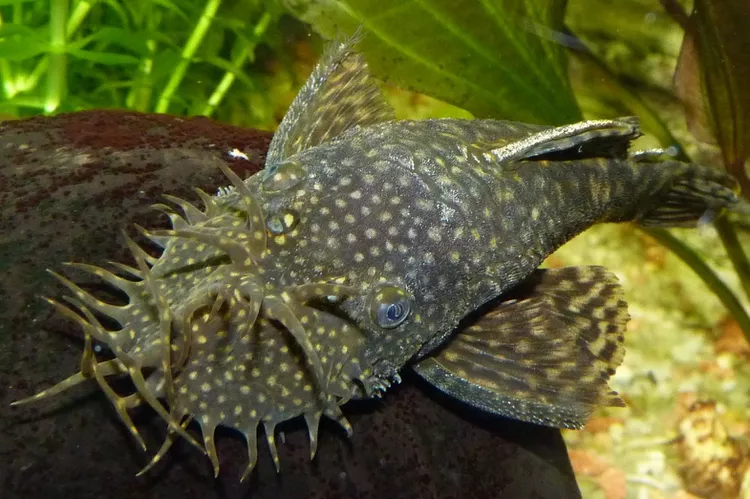
Size
4 to 5 inches
Physical Characteristics
They have white or yellow spots scattered across their brown, green, or gray bodies. Some have uneven coloring, with lighter and darker splotches on different areas of their bodies. All Bristlenose Plecos have the “bristles” on their heads. They are far more noticeable in men, though. They tend to grow higher up on the head and are longer. The bristles appear around the mouth area in females but are a little less prominent.
Temperament
The temperament of bristlenose plecos is quite calm and gregarious. They hardly ever act violently towards other fish. Because of this, you can keep them in a tank with most species that inhabit similar water conditions.
Habitat
The Amazon River Basin in South America is where the Bristlenose Pleco (Ancistrus cirrhosus) first appeared. The Amazon River’s rivers and floodplains are the source of bristlenose catfish.
Keeping as Pet

- Tank Size
Make sure your Bristlenose Plecos have at least a 25 gallon tank to roam around in if you intend to get any. If you choose to keep them alongside other fish, make sure to modify the size of your tank appropriately (more on that below).
You should build their habitat with the fact that they naturally live on the bottom in mind. You’ll note that your fish spend the most of their time near any decorations or at the tank’s bottom, where they scavenge for food.
- Water Conditions
Make sure the tank has the proper water conditions when you’ve finished setting it up. Bristlenose Plecos thrive in a range of environments. But, to enhance their health and lifetime, you should aim for the following:
60 to 80 degrees Fahrenheit is the range for the water’s temperature.
pH: 6.5 to 7.5 is the approximate range.
Hardness of water: 6 to 10 KH
- Feeding
It is advisable to give algae or spirulina wafers once or twice daily since bristlenose plecos are herbivores that mostly consume algae. In addition to occasional zucchini slices, blanched romaine lettuce, or spinach are nice rewards, as are granules, flakes, or bloodworms. Just be careful not to overeat. The coloring of well-fed plecos makes it obvious when their nutritional needs are being met. The Bristlenose Pleco spends some of its time searching through the substrate for algae and other debris, like other catfish do. This is obviously a big benefit because it makes the tank much cleaner.
- Tank mates
Bristlenose Plecos get along well with any calm fish and can be housed with other fish that graze on algae, such as grazing fish or snails. They work well in tanks with other species such as neon tetras, platys, guppys, and others. Some aquarium keepers even pair them with fish that are known to be aggressive, such bettas or African cichlids, or even with species who are rivals, like goldfish. When plecos mature, the males can become fiercely aggressive towards one another.
Table





